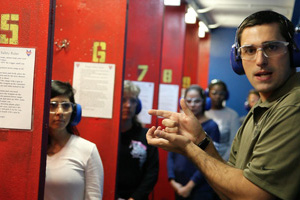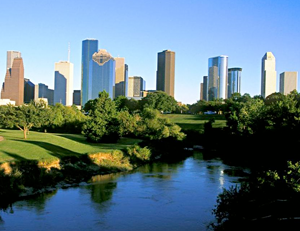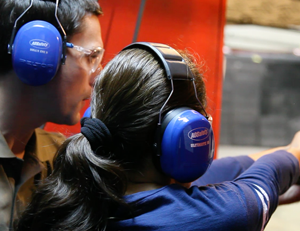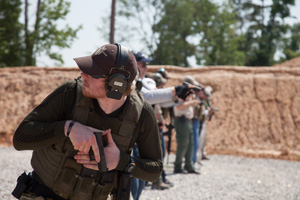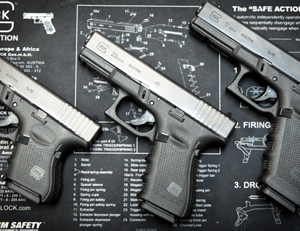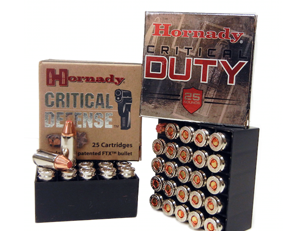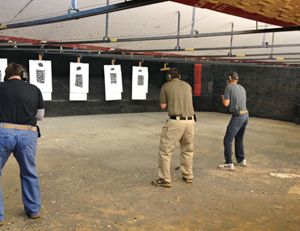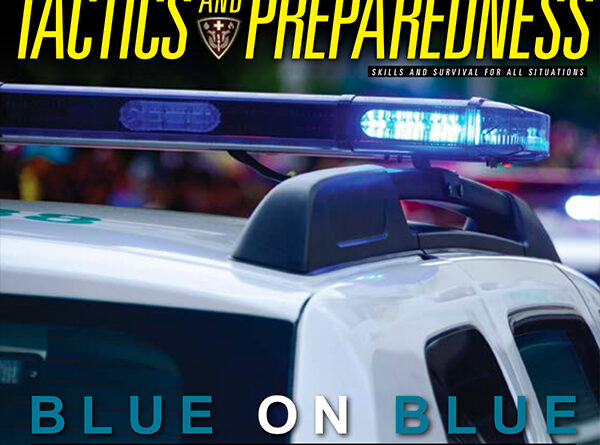
18
BLUE ON BLUE MISHAPS
BLUE ON BLUE MISHAPS
By Kent O’Donnell, Tactics and Preparedness November 2018
As the lead firearms instructor and a SWAT member in an American police department, I have been asked to sit on many review boards for officer involved shootings.
The goal of such reviews is to determine if an officer acted correctly, acted inappropriately or if there was a training failure. In some cases, the officer acted lawfully, within policy, in accordance with training and we still find a training failure; meaning the department did not provide sufficient training. This is not a popular finding, but it is sometimes the correct one.
It is difficult to have an officer off the street for required training, and nearly impossible to get enough time to train to the highest level of gunfighter for the wide range of situations that may occur. Training has been designed to get a large number of trainees through a number of base scenarios, from which the officer will draw from when faced with every situation in the real world. This is at the best departments. Some departments lack night shooting, shooting moving targets and shooting with “no-shoot” targets and “shoot” targets that are moving.
Departments with video training solutions do this, but not every department does. Do you train to a higher standard than the law enforcement agencies in your area? Is there any reason to believe you are capable of better results than they achieve if you don’t? Would you like to learn from their mistakes?
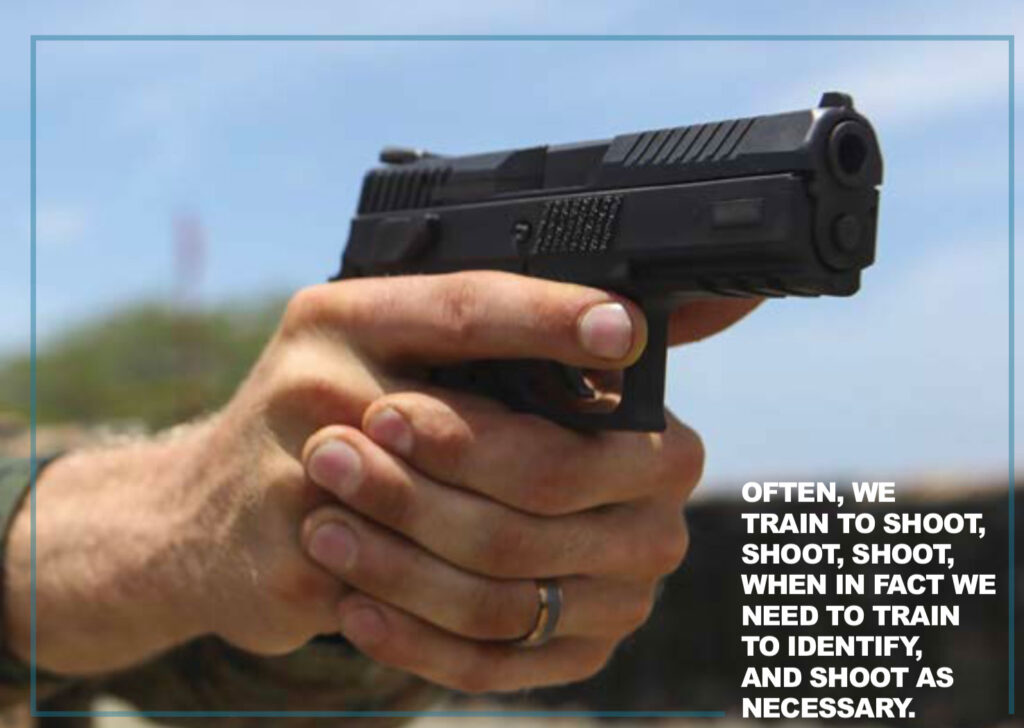
NEW YORK, NEW YORK, 2012
On 24th August 2012, Suspect Jeffery T. Johnson, age 58, killed a co-worker on the 33rd street side of the Empire State Building. Using a .45 caliber handgun, Johnson came out from hiding behind a van and shot his co-worker one time in the head, then stood over him, shooting him four more times. Johnson walked east on 33rd then north on Fifth Avenue. A construction worker who witnessed the shooting followed him. In front of the Empire State building, the construction worker alerted two police officers stationed there. We can see (on CCTV footage), the officers approach Johnson from behind. Johnson turned to face the officers who were running toward him almost in a single file line.
The first officer appears to be left-handed and had his weapon holstered. The second officer was right-handed, had his weapon drawn and pointed at the suspect, using a strong-handonly grip. Johnson looked over his shoulder at the police. He knew they were after him.
He produced the handgun and held it strong hand only in a modified high compressed ready, with the muzzle clearly pointed toward the officers and general public. The front officer stopped running and started back peddling. They were approximately within 12 to 20 feet of each other. The street had vehicle traffic and the side walk had typical New York pedestrian traffic. All three people were on the curb side of the side walk, almost linear, with the second officer slightly offset to the building side of the sidewalk when the shooting began. The investigation revealed that the suspect did not fire. He appears to have experienced a stoppage, but it is clear he attempted to fire. The front officer backed away and toward the street side while drawing to fire with a two-handed grip. The second officer moved away from the front officer, moving toward the building side and fired while moving laterally with a strong hand only grip. The police officers fired a combined 16 rounds at the suspect
Nine bystanders were wounded by stray rounds as well as rounds passing through the suspect, ricochets or bullet fragments. Applying the standard basic academy shooting solutions of: seek cover, in a crowd take a knee and shoot upward, and try to use the “L” (as in an shaped ambush) of contact and cover to shoot from two directions, and avoid cross fire situations; what could have happened? Seek cover: hiding behind the low planters would have placed the officer’s heads at near muzzle level with how the suspect was holding the weapon.
This was not a solution at this close distance. Taking a knee would have caused a loss of mobility and the suspect was very mobile during the shooting. Additionally, shooting up in a city full of tall buildings puts your rounds into a faraway office window. Kneeling and using the angle was not the best option. The last skill: separate and use angles to avoid cross fire, but still divide the suspect’s attention, was tried by the officers to some extent.
f you are ever forced to fight it out with a bad guy in a crowd there are several things to consider. Many organizations have a safety rule that states, “Never point your weapon at anything you are not willing to destroy”. In a crowd, Max Joseph’s “position SUL” (Portuguese for South) allows you to draw the weapon to a high compressed position in front of your chest with the muzzle pointed straight down, angled toward the space in front of your toes. The weapon does not get pointed at anyone, and you are more than half way to “ontarget” for fast presentation once you have a shot you can make. A stwo hands on the weapon whenever possible.
We also know we get the most accurate shots on target when we are standing still whether the target is moving or not; so post up, shoot fast, and win with fewer shots. A well-trained shooter can hit targets from distances where most suspects lack skill. In this case, shooting and advancing would have placed more citizens behind you, which may have been better. Targeting the shooter’s pelvis may be an option to reduce his mobility if the angle is advantageous. These officers were given a very challenging situation and applied the best skills they had. Avoid gunfights in crowds if at all possible. If you find yourself forced into such a fight, do not press the trigger on shots that you cannot guarantee. If you shoot nine bystanders in a future incident, you can reasonably expect to face criminal prosecution and a great deal of civil liability.
LAKEWOOD, COLORADO, 2012
In November of 2012, in Lakewood Colorado, police responded to a loud party. Upon arrival, a sergeant observed a subject fire a weapon nearby. Numerous officers from multiple departments and air support responded to an assistance request and arrived on the scene.
The search led officers to a house where they believed the suspect might be. An ad hoc SWAT situation began. Three people inside the house exited after a SWAT negotiator spoke with them by phone. The three individuals were taken into custody without incident and no weapons were found. A Lakewood officer and his partner walked to the back of the residence to make sure no one ran out the back. The resident advised there were pit bulls in the house. Additional officers responded to assist with the dogs and searching the house. A SWAT team leader (TL) was in the house, and was advised the back yard had not been searched. The Lakewood officer was at the back door when he believed he heard voices in the back yard.
He and two other officers exited the house to a car port and began searching. The SWAT TL was alerted by a voice that said to him, “hey”. The TL stated he saw a bald-headed Hispanic male with a black pistol in one hand, and a flashlight in the other hand looking over the top of a six-foot privacy fence. The TL stated he yelled, “Police! Drop the gun! Drop the gun!” The person did not comply, and the TL stated the individual raised the weapon in his direction. The TL fired six rounds. One of which struck the Lakewood officer in the head, killing him. The distance between the two officers was between 23 and 25 feet. The SWAT TL was using a patrol rifle with a light mounted on it. He activated the light as he ordered the person to drop the weapon. Many organizations have a safety rule that states, “Be sure of your target and what is beyond”. With a rifle, the distance the round will travel is even greater than a pistol. Low light or night shooting with a duty handgun is often required. Night shooting with a patrol rifle or shotgun is not required in all agencies. When searching in low light conditions the weapon muzzle can be depressed to 45 degrees allowing you to search with the spill of the light, using the beam of the light to blind the suspect is one last escalation-of-force.
When shooters are trained to scan before re-holstering, they often look left and right with their heads, but do not see and process what they are not expecting to see. In this situation, the officer who fired reported seeing the black semi-auto pistol and the flash light. It seems that these did not process beyond the point that it could be a bad guy. We must train no-shoot scenarios, not games or impossible scenarios, but scenarios that the student can input into his or her brain that three clues make three. Not one, not two, but three. Often, we train to shoot, shoot, shoot, when in fact we need to train to identify, and shoot as necessary. This could have been a dad who woke up in the night to a noise and then found his own son sneaking home. You must see and process information, not just look.
MORGAN HILL, CALIFORNIA
Four teenagers stole a van. The male driver had a criminal history. They all agreed to commit the crime. The police were looking for the stolen van and spotted it. A pursuit ensued.
The chase ended in a crash with the van hitting a light pole and a fire hydrant. As two female passengers exited the vehicle during a rapidly developing felony stop, one senior officer ordered a girl to lay on the ground. Sirens blared, cops were yelling instructions and the officer unintentionally fired his weapon. The round hit the ground and a fragment struck the other girl already prone on the ground. She sustained a minor injury, was treated and released. Many organizations have a safety rule that states, “Keep your finger straight and off the trigger until you are ready to fire”. We know that when we carry out an action with one hand (for example, squeezing something) the other hand often will do something similar. We know that if we startle, we tend to squeeze our hands together. Whether you are a law enforcement agent or an armed citizen, we must train. We must train to be accurate when we shoot, and we must train to be accurate in our decision to shoot. We must have appropriate gear (for example, lights and weapon mounted lights so we can positively identify the target). Shooting a local match just once a month will sharpen your skills and show you your limitations with much more precision than the majority of armed professionals have. Be careful at the range and in the world.
- Treat all weapons as if they are loaded
- Keep your weapon pointed in a safe direction.
- Keep your finger off the trigger.
- Be sure of your target and what lies beyond it.
Get trained to a higher standard, shoot moving targets, and practice threat identification
BIO
Kent O’Donnell is a former Recon Marine and a retired police sergeant. He spent most of his career on his department’s SWAT team. Kent has done risk and security audits and training throughout west Africa, South America and Europe and provided weapons and tactics training around the world. Kent worked on a U.S. government project in Libya for six months and currently serves with 360 Worldwide Security.

18
BLUE ON BLUE MISHAPS
BLUE ON BLUE MISHAPS
By Kent O’Donnell, Tactics and Preparedness November 2018
As the lead firearms instructor and a SWAT member in an American police department, I have been asked to sit on many review boards for officer involved shootings.
The goal of such reviews is to determine if an officer acted correctly, acted inappropriately or if there was a training failure. In some cases, the officer acted lawfully, within policy, in accordance with training and we still find a training failure; meaning the department did not provide sufficient training. This is not a popular finding, but it is sometimes the correct one.
It is difficult to have an officer off the street for required training, and nearly impossible to get enough time to train to the highest level of gunfighter for the wide range of situations that may occur. Training has been designed to get a large number of trainees through a number of base scenarios, from which the officer will draw from when faced with every situation in the real world. This is at the best departments. Some departments lack night shooting, shooting moving targets and shooting with “no-shoot” targets and “shoot” targets that are moving.
Departments with video training solutions do this, but not every department does. Do you train to a higher standard than the law enforcement agencies in your area? Is there any reason to believe you are capable of better results than they achieve if you don’t? Would you like to learn from their mistakes?

NEW YORK, NEW YORK, 2012
On 24th August 2012, Suspect Jeffery T. Johnson, age 58, killed a co-worker on the 33rd street side of the Empire State Building. Using a .45 caliber handgun, Johnson came out from hiding behind a van and shot his co-worker one time in the head, then stood over him, shooting him four more times. Johnson walked east on 33rd then north on Fifth Avenue. A construction worker who witnessed the shooting followed him. In front of the Empire State building, the construction worker alerted two police officers stationed there. We can see (on CCTV footage), the officers approach Johnson from behind. Johnson turned to face the officers who were running toward him almost in a single file line.
The first officer appears to be left-handed and had his weapon holstered. The second officer was right-handed, had his weapon drawn and pointed at the suspect, using a strong-handonly grip. Johnson looked over his shoulder at the police. He knew they were after him.
He produced the handgun and held it strong hand only in a modified high compressed ready, with the muzzle clearly pointed toward the officers and general public. The front officer stopped running and started back peddling. They were approximately within 12 to 20 feet of each other. The street had vehicle traffic and the side walk had typical New York pedestrian traffic. All three people were on the curb side of the side walk, almost linear, with the second officer slightly offset to the building side of the sidewalk when the shooting began. The investigation revealed that the suspect did not fire. He appears to have experienced a stoppage, but it is clear he attempted to fire. The front officer backed away and toward the street side while drawing to fire with a two-handed grip. The second officer moved away from the front officer, moving toward the building side and fired while moving laterally with a strong hand only grip. The police officers fired a combined 16 rounds at the suspect
Nine bystanders were wounded by stray rounds as well as rounds passing through the suspect, ricochets or bullet fragments. Applying the standard basic academy shooting solutions of: seek cover, in a crowd take a knee and shoot upward, and try to use the “L” (as in an shaped ambush) of contact and cover to shoot from two directions, and avoid cross fire situations; what could have happened? Seek cover: hiding behind the low planters would have placed the officer’s heads at near muzzle level with how the suspect was holding the weapon.
This was not a solution at this close distance. Taking a knee would have caused a loss of mobility and the suspect was very mobile during the shooting. Additionally, shooting up in a city full of tall buildings puts your rounds into a faraway office window. Kneeling and using the angle was not the best option. The last skill: separate and use angles to avoid cross fire, but still divide the suspect’s attention, was tried by the officers to some extent.
f you are ever forced to fight it out with a bad guy in a crowd there are several things to consider. Many organizations have a safety rule that states, “Never point your weapon at anything you are not willing to destroy”. In a crowd, Max Joseph’s “position SUL” (Portuguese for South) allows you to draw the weapon to a high compressed position in front of your chest with the muzzle pointed straight down, angled toward the space in front of your toes. The weapon does not get pointed at anyone, and you are more than half way to “ontarget” for fast presentation once you have a shot you can make. A stwo hands on the weapon whenever possible.
We also know we get the most accurate shots on target when we are standing still whether the target is moving or not; so post up, shoot fast, and win with fewer shots. A well-trained shooter can hit targets from distances where most suspects lack skill. In this case, shooting and advancing would have placed more citizens behind you, which may have been better. Targeting the shooter’s pelvis may be an option to reduce his mobility if the angle is advantageous. These officers were given a very challenging situation and applied the best skills they had. Avoid gunfights in crowds if at all possible. If you find yourself forced into such a fight, do not press the trigger on shots that you cannot guarantee. If you shoot nine bystanders in a future incident, you can reasonably expect to face criminal prosecution and a great deal of civil liability.
LAKEWOOD, COLORADO, 2012
In November of 2012, in Lakewood Colorado, police responded to a loud party. Upon arrival, a sergeant observed a subject fire a weapon nearby. Numerous officers from multiple departments and air support responded to an assistance request and arrived on the scene.
The search led officers to a house where they believed the suspect might be. An ad hoc SWAT situation began. Three people inside the house exited after a SWAT negotiator spoke with them by phone. The three individuals were taken into custody without incident and no weapons were found. A Lakewood officer and his partner walked to the back of the residence to make sure no one ran out the back. The resident advised there were pit bulls in the house. Additional officers responded to assist with the dogs and searching the house. A SWAT team leader (TL) was in the house, and was advised the back yard had not been searched. The Lakewood officer was at the back door when he believed he heard voices in the back yard.
He and two other officers exited the house to a car port and began searching. The SWAT TL was alerted by a voice that said to him, “hey”. The TL stated he saw a bald-headed Hispanic male with a black pistol in one hand, and a flashlight in the other hand looking over the top of a six-foot privacy fence. The TL stated he yelled, “Police! Drop the gun! Drop the gun!” The person did not comply, and the TL stated the individual raised the weapon in his direction. The TL fired six rounds. One of which struck the Lakewood officer in the head, killing him. The distance between the two officers was between 23 and 25 feet. The SWAT TL was using a patrol rifle with a light mounted on it. He activated the light as he ordered the person to drop the weapon. Many organizations have a safety rule that states, “Be sure of your target and what is beyond”. With a rifle, the distance the round will travel is even greater than a pistol. Low light or night shooting with a duty handgun is often required. Night shooting with a patrol rifle or shotgun is not required in all agencies. When searching in low light conditions the weapon muzzle can be depressed to 45 degrees allowing you to search with the spill of the light, using the beam of the light to blind the suspect is one last escalation-of-force.
When shooters are trained to scan before re-holstering, they often look left and right with their heads, but do not see and process what they are not expecting to see. In this situation, the officer who fired reported seeing the black semi-auto pistol and the flash light. It seems that these did not process beyond the point that it could be a bad guy. We must train no-shoot scenarios, not games or impossible scenarios, but scenarios that the student can input into his or her brain that three clues make three. Not one, not two, but three. Often, we train to shoot, shoot, shoot, when in fact we need to train to identify, and shoot as necessary. This could have been a dad who woke up in the night to a noise and then found his own son sneaking home. You must see and process information, not just look.
MORGAN HILL, CALIFORNIA
Four teenagers stole a van. The male driver had a criminal history. They all agreed to commit the crime. The police were looking for the stolen van and spotted it. A pursuit ensued.
The chase ended in a crash with the van hitting a light pole and a fire hydrant. As two female passengers exited the vehicle during a rapidly developing felony stop, one senior officer ordered a girl to lay on the ground. Sirens blared, cops were yelling instructions and the officer unintentionally fired his weapon. The round hit the ground and a fragment struck the other girl already prone on the ground. She sustained a minor injury, was treated and released. Many organizations have a safety rule that states, “Keep your finger straight and off the trigger until you are ready to fire”. We know that when we carry out an action with one hand (for example, squeezing something) the other hand often will do something similar. We know that if we startle, we tend to squeeze our hands together. Whether you are a law enforcement agent or an armed citizen, we must train. We must train to be accurate when we shoot, and we must train to be accurate in our decision to shoot. We must have appropriate gear (for example, lights and weapon mounted lights so we can positively identify the target). Shooting a local match just once a month will sharpen your skills and show you your limitations with much more precision than the majority of armed professionals have. Be careful at the range and in the world.
- Treat all weapons as if they are loaded
- Keep your weapon pointed in a safe direction.
- Keep your finger off the trigger.
- Be sure of your target and what lies beyond it.
Get trained to a higher standard, shoot moving targets, and practice threat identification
BIO
Kent O’Donnell is a former Recon Marine and a retired police sergeant. He spent most of his career on his department’s SWAT team. Kent has done risk and security audits and training throughout west Africa, South America and Europe and provided weapons and tactics training around the world. Kent worked on a U.S. government project in Libya for six months and currently serves with 360 Worldwide Security.

